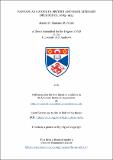Files in this item
Fantasy as a mode in British and Irish literary decadence, 1885–1925
Item metadata
| dc.contributor.advisor | Sutton, Emma | |
| dc.contributor.advisor | Plain, Gill | |
| dc.contributor.author | Mercurio, Jeremiah Romano | |
| dc.coverage.spatial | 274 | en_US |
| dc.date.accessioned | 2011-08-10T15:42:50Z | |
| dc.date.available | 2011-08-10T15:42:50Z | |
| dc.date.issued | 2011-06-21 | |
| dc.identifier.uri | https://hdl.handle.net/10023/1964 | |
| dc.description.abstract | This Ph.D. thesis investigates the use of fantasy by British and Irish 'Decadent' authors and illustrators, including Oscar Wilde, Max Beerbohm, Aubrey Beardsley, 'Vernon Lee' (Violet Paget), Ernest Dowson, and Charles Ricketts. Furthermore, this study demonstrates why fantasy was an apposite form for literary Decadence, which is defined in this thesis as a supra-generic mode characterized by its anti-mimetic impulse, its view of language as autonomous and artificial, its frequent use of parody and pastiche, and its transgression of boundaries between art forms. Literary Decadence in the United Kingdom derives its view of autonomous language from Anglo-German Romantic philology and literature, consequently being distinguished from French Decadence by its resistance to realism and Naturalism, which assume language's power to signify the 'real world'. Understanding language to be inorganic, Decadent writers blithely countermand notions of linguistic fitness and employ devices such as catachresis, paradox, and tautology, which in turn emphasize the self-referentiality of Decadent texts. Fantasy furthers the Decadent argument about language because works of fantasy bear no specific relationship to 'reality'; they can express anything evocable within language, as J.R.R. Tolkien demonstrates with his example of "the green sun" (a phrase that can exist independent of the sun's actually being green). The thesis argues that fantasy's usefulness in underscoring arguments about linguistic autonomy explains its widespread presence in Decadent prose and visual art, especially in genres that had become associated with realism and Naturalism, such as the novel (Chapter 1), the short story (Chapter 3), drama (Chapter 4), and textual illustration (Chapter 2). The thesis also analyzes Decadents' use of a wholly non-realistic genre, the fairy tale (see Chapter 5), in order to delineate the consequences of their use of fantasy for the construction of character and gender within their texts. | en_US |
| dc.language.iso | en | en_US |
| dc.publisher | University of St Andrews | |
| dc.rights | Creative Commons Attribution-NonCommercial-NoDerivs 3.0 Unported | |
| dc.rights.uri | http://creativecommons.org/licenses/by-nc-nd/3.0/ | |
| dc.subject | Decadence | en_US |
| dc.subject | Fantasy | en_US |
| dc.subject | Illustrated books | en_US |
| dc.subject | Gender identity in literature | en_US |
| dc.subject | Oscar Wilde | en_US |
| dc.subject | Max Beerbohm | en_US |
| dc.subject | Vernon Lee | en_US |
| dc.subject | Aubrey Beardsley | en_US |
| dc.subject | Charles Ricketts | en_US |
| dc.subject | Ernest Dowson | en_US |
| dc.subject.lcc | PR468.D43M4 | |
| dc.subject.lcsh | Decadence (Literary movement)--Great Britain | en_US |
| dc.subject.lcsh | Decadence (Literary movement)--Ireland | en_US |
| dc.subject.lcsh | Fantasy literature--19th century--History and criticism | en_US |
| dc.subject.lcsh | Fantasy literature--20th century--History and criticism | en_US |
| dc.subject.lcsh | Illustration of books--Great Britain | en_US |
| dc.subject.lcsh | Illustration of books--Ireland | en_US |
| dc.subject.lcsh | Fantasy in literature | en_US |
| dc.title | Fantasy as a mode in British and Irish literary decadence, 1885–1925 | en_US |
| dc.type | Thesis | en_US |
| dc.type.qualificationlevel | Doctoral | en_US |
| dc.type.qualificationname | PhD Doctor of Philosophy | en_US |
| dc.publisher.institution | The University of St Andrews | en_US |
| dc.rights.embargoreason | Embargo period has ended, thesis made available in accordance with University regulations. | en_US |
| dc.identifier.doi | https://doi.org/10.17630/10023-1964 |
This item appears in the following Collection(s)
Except where otherwise noted within the work, this item's licence for re-use is described as Creative Commons Attribution-NonCommercial-NoDerivs 3.0 Unported
Items in the St Andrews Research Repository are protected by copyright, with all rights reserved, unless otherwise indicated.


